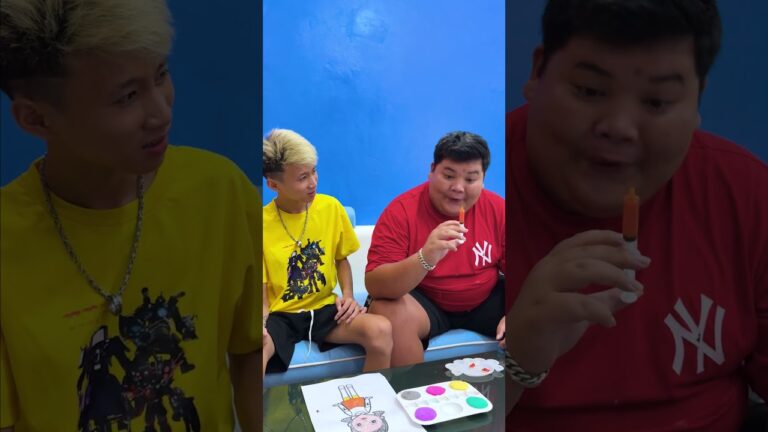[ad_1]
Okay, here’s a detailed explanation of how to make orange paint, likely based on the content you might find in a short video titled "Fun Fun TV : How to make orange paint #shorts":
Understanding Orange as a Secondary Color:
Orange is a secondary color, meaning it’s created by mixing two primary colors. The primary colors needed to make orange are red and yellow.
Materials You’ll Likely Need:
- Red Paint: A tube or bottle of red paint. The shade of red will influence the final orange. Warmer reds (leaning towards orange) will create brighter oranges. Cooler reds (leaning towards magenta) might create duller or more muted oranges.
- Yellow Paint: A tube or bottle of yellow paint. Similar to red, the shade of yellow matters. A warm yellow (leaning towards orange) will contribute to a brighter orange. A cooler yellow (leaning towards green) might make a slightly muddier orange if not mixed carefully.
- Mixing Surface: A palette (disposable paper palette, plastic palette, or even a ceramic plate) to mix the paints on.
- Palette Knife or Brush: A tool for scooping and mixing the paint. A palette knife is ideal for thorough mixing, while a brush can be used but requires more care to avoid contaminating the colors.
- Water (Optional): To thin the paint if needed, especially if using acrylics that dry quickly. Use sparingly.
- Paintbrush: For applying the orange paint. Choose a brush appropriate for the surface you’ll be painting on.
- Paper Towels or Rag: For cleaning your brush and palette knife.
- Container for Water (If using): To clean your brush.
Steps to Mix Orange Paint:
-
Dispense the Paints: Place a small amount of red and yellow paint onto your mixing surface, keeping them separate initially. Start with approximately equal amounts.
-
The Importance of the Ratio: The ratio of red to yellow significantly impacts the resulting shade of orange.
- More Red: Will create a darker, redder orange.
- More Yellow: Will create a lighter, yellower orange.
- Equal Parts (approximately): Will create a balanced, classic orange.
-
Start Mixing Carefully: Use your palette knife or brush to scoop a small amount of one of the colors (either red or yellow) and begin gently folding it into the other color. Avoid swirling or aggressively mixing at first, as this can introduce air bubbles.
-
Thorough Mixing: Continue to mix the two colors thoroughly until you achieve a uniform color with no streaks or swirls of the original red or yellow. Scrape the edges of the paint pile to ensure all the color is consistent.
-
Adjusting the Shade:
- To make the orange brighter: Add a small amount of yellow. Mix thoroughly.
- To make the orange darker: Add a very small amount of red. Mix thoroughly. Add red very cautiously, as it can easily overpower the yellow.
- To make the orange more muted (less vibrant): You can add a tiny amount of blue (the opposite color of orange on the color wheel). However, this is tricky and can easily turn the orange muddy brown. It is usually better to achieve a muted orange by selecting less vibrant starting red and yellow pigments.
-
Testing the Color: Before applying the orange paint to your final surface, test it on a scrap piece of paper or canvas to ensure it’s the shade you desire.
- Thinning the Paint (Optional): If the paint is too thick, add a very small amount of water (if using acrylics) or the appropriate thinner for the type of paint you’re using (e.g., linseed oil for oil paints). Mix thoroughly. Adding too much water will make the paint thin and transparent.
Tips and Considerations:
- Start Small: Begin with small amounts of paint, as you can always add more. It’s wasteful to mix large quantities that you don’t need.
- Clean Your Tools: Regularly clean your palette knife or brush to prevent color contamination.
- Paint Types: The specific instructions might vary slightly depending on the type of paint you are using (acrylic, oil, watercolor, etc.). Acrylics dry quickly, so work efficiently. Oil paints take longer to dry, allowing more time for blending. Watercolors are transparent and require a different approach to mixing.
- Color Theory: Understanding basic color theory (primary, secondary, complementary colors) will help you predict the results of your mixtures.
- Experimentation: Don’t be afraid to experiment with different ratios of red and yellow to create a variety of orange shades.
- White Paint: Adding white paint will tint (lighten) the orange creating pastel oranges.
Potential Issues and Solutions:
- Muddy Orange: If the orange turns muddy or brown, it’s likely because you added too much of a third color (especially blue or black). Try to start over with fresh red and yellow.
- Uneven Color: If the orange looks streaky, you haven’t mixed it thoroughly enough. Continue mixing until the color is uniform.
- Paint Drying Too Fast: If using acrylics, work quickly or use a retarder to slow down the drying time.
[ad_2]

